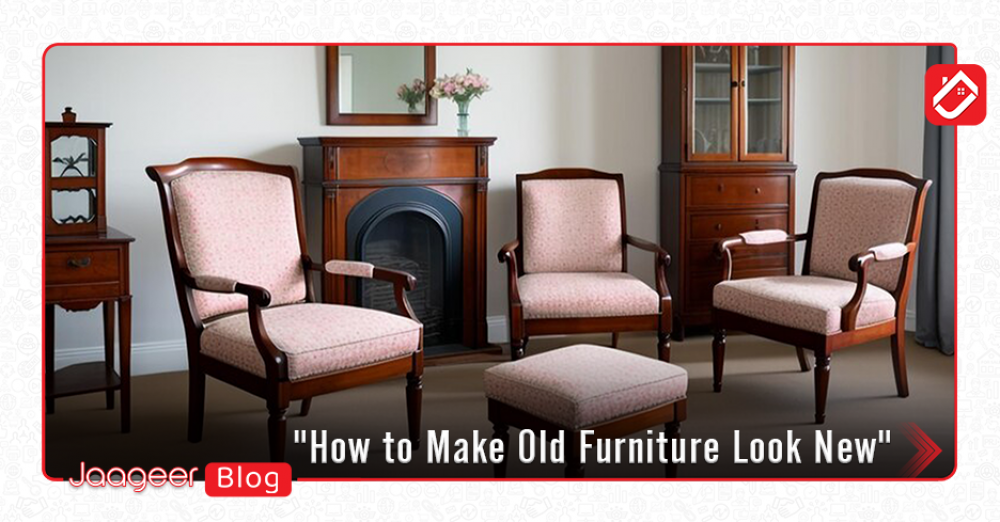Are you tired of walking into your living room and feeling like your furniture has been improved for years? Perhaps your once-beloved pieces are showing their age, with scratches, scuffs, and worn-out finishes. It's a vulgar dilemma, and the serious word is that you don't have to replace all your furniture to give your space a fresh, updated look. Instead, you can learn how to micturate old furniture and look new with simply a little creativity and effort.
This comprehensive guide testament explores seven groundbreaking ideas that will breathe new life into your old furniture. Whether you're a seasoned DIY enthusiast or a complete novice, these tips are unintentional to help you revitalize your furniture while staying within your budget.

1. Start with a Fresh Coat of Paint
One of the most straightforward and effective shipways to transform old furniture is by gift it a novel pelage of paint. This method works wonders for wooden and metal furniture likewise. Here's how you can do it:
Step 1:Prepare the Surface: Begin by sanding the old finish or pigment of the furniture's rise. This step helps make a smooth and fifty-fifty pedestal for the new paint.
Step 2:Choose Your Paint: Select a pigment color that complements your room's decor. Whether you prefer classic white, bold, and vivacious hues or subtle pastels, the prime is yours.
Step 3:Apply the Paint: Use a paintbrush or a paint sprayer for a professional finish. Apply the paint evenly, allowing each pelage to dry well before adding another. You may want two or more coats for end coverage.
Step 4: Add a Protective Finish: After the paint has dried, consider adding a clear protective goal, like polyurethane, to protect your freshly painted furniture from wear and tear.
2. Refinish the Wood
If you have wooden furniture, refinishing the wood can significantly enhance its show. Over-clip, wooden surfaces can become dull and scratched, but with the right technique, you can restore their natural beauty. Here's how:
Step 1:Strip the Old Finish: Use a pigment striptease to take the old finish. Follow the manufacturer's instructions carefully.
Step 2:Sand the Wood: Once the old finish is removed, sand the wood to create a smooth surface. Start with coarse-grit sand and gradually work your way up to finer grits.
Step 3:Apply Stain or Varnish: Choose a wood stain or seal that complements your decor and apply it according to the product's instructions. This step will give your furniture a rich, glossy finish.
3. Reupholstering for a Fresh Look
Older furniture with worn-out upholstery can be given a new rental on life through reupholstering. This process allows you to select fabrics that match your title and preferences. Here's how to reupholster furniture:
Step 1:Remove the Old Fabric: Carefully transfer the existing fabric, noting how it was attached.
Step 2: Add New Padding: If necessary, replace or add new padding to raise ease and support.
Step 3:Attach the New Fabric: Stretch the new fabric over the furniture's cast and untrouble it using staples or upholstery tracks. Trim any excess fabric for a clean finish.
Step 4:Finishing Touches: Consider adding decorative elements like a headdress or tufting to elevate the look of your reupholstered furniture.
4. Adding New Hardware
Sometimes, it's the little details that piss the most significant difference in the show of your furniture. Swapping out old, worn-out ironware, such as handles, knobs, or pulls, can instantly update the appearance of your pieces. Here's how to do it:
Step 1:Remove the Old Hardware: Carefully remove the existing ironware using a screwdriver or a wrench.
Step 2:Select New Hardware: Choose hardware that suits your style and complements the furniture's design. There are innumerous options available, from sleek and Bodoni to vintage and ornate.
Step 3:Install the New Hardware: Attach the new ironware using the provided screws or fasteners. Make sure it's firmly in place.

5. Creative Decoupage Techniques
Decoupage is a fantastic way to add part and personality to your old furniture. This technique involves adhering paper or cloth to the rise using a special adhesive. You can create a wide straddle of looks, from vintage and hard-pressed to whimsical and artistic. Here's how to get started with decoupage:
Step 1:Gather Your Materials: You'll need your chosen paper or fabric, decoupage gum, a brush, and a rose to work on.
Step 2:Prepare the Surface: Ensure your furniture's rise is clean and smooth. Sand it if necessary.
Step 3:Apply the Adhesive: Brush a layer of decoupage glue onto the furniture's surface.
Step 4: Add the Paper/Fabric: Carefully place your chosen paper or fabric onto the glue, smoothing out any wrinkles or bubbles as you go.
Step 5: Seal the Surface: Once the adhesive dries, apply additional coats to seal the rise and protect your decoupage design.
6. Explore Stenciling and Patterns
Stenciling is a fun and innovative way to add patterns and designs to your furniture. Whether you prefer floral motifs, geometric shapes, or intricate borders, stencils extend endless possibilities for customization. Here's how to stencil your furniture:
Step 1:Choose Your Stencil: Select a stencil design that suits your style and furniture piece.
Step 2:Position the Stencil: Secure the stencil in place on your furniture using painter's tape.
Step 3:Apply the Paint: Use a stencil brush or poriferan to hold paint equally within the stencil's openings. Be trusted to use painter's taping to mask off areas you don't want to paint.
Step 4:Remove the Stencil: Carefully remove the stencil while the pigment is still wet to reveal your design.

7. Preserving the Vintage Charm
If you want to maintain the vintage charm of your furniture, deal with minor repairs and maintenance. This step involves fixing loose joints, regulating veneering, and addressing any structural issues. By preserving the original unity of your piece, you can showcase its history and graph piece ensuring it remains functional and beautiful.
In conclusion, you don't need to splurge on new furniture to present your home with a fresh and updated appearance. Learning how to make old furniture look new is a rewarding endeavor that can save you money and allow you to utter your creativity. Whether you prefer to paint, refinish, reupholster, add new hardware, explore decoupage, stencil, or preserve vintage charm, these 7 ideas will help you metamorphose your old furniture into stunning pieces that respire new living into your living space. So, vagabond up your sleeves, pucker your supplies, and embark on your furniture makeover journey today!








